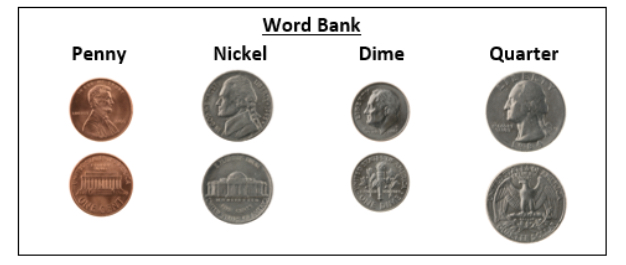Clarifications
Clarification 1: Instruction includes the recognition of both sides of a coin.Clarification 2: Within this benchmark, the expectation is not to use decimal values.
Benchmark Instructional Guide
Connecting Benchmarks/Horizontal Alignment
Terms from the K-12 Glossary
- NA
Vertical Alignment
Previous Benchmarks
- This is the first grade level where students will explore money concepts.
Next Benchmarks
Purpose and Instructional Strategies
The purpose of this benchmark is for students to formally recognize the respective value of coins (MTR.5.1, MTR.7.1).- Instruction includes both the front and back sides of pennies, nickels, dimes and quarters.
- Instruction emphasizes that the relative size of the coin is not representative of its value in comparison to other coins (MTR.5.1).
- Instruction uses the format 25¢, not $0.25.
Common Misconceptions or Errors
- Students may believe the value of a coin is directly related to its size (e.g., a nickel is bigger than a dime and is worth more, or a penny is bigger than a dime, so it must also be worth more). In these cases students need additional practice identifying a coin with its actual value.
Strategies to Support Tiered Instruction
- Teacher provides opportunities to use descriptive language to discuss observable details of each coin and record their observations in a chart. Students can use a magnifying lens to notice details closely. As students practice identifying coins with their values, they can use the chart as a reference.
- For example, a chart (like the one below) can be used to organize the information students observe about the coins. Student misconceptions about coins can be observed by the teacher and guided toward understanding in the “What do you notice or wonder?” column.

- Information from the chart can be made into cards for students to sort using each coin name as a header.

- Teacher asks questions to elicit ideas of what students notice about the coins and those that require students to make comparisons such as:
- “What do you notice about the outside edge of this coin? Why do you think some coins have ridges?”
- “Who is on the smallest coin?”
- “What are the words you see on the penny?”
- “Do all of the coins tell their value?”
Instructional Tasks
Instructional Task 1 (MTR.7.1)
- Part A. Using the table below, identify each coin’s name and its value.
- Part B. What is the total value of the coins on the table?
- Part C. With a partner, compare your value column and discuss if you both came up with the same total. What could you do to figure out who is right or check your work for accuracy?

Instructional Items
Instructional Item 1


*The strategies, tasks and items included in the B1G-M are examples and should not be considered comprehensive.
Related Courses
Related Access Points
Related Resources
Formative Assessments
Lesson Plans
Original Student Tutorials
MFAS Formative Assessments
Students are shown various coins and are asked to identify the name and value of each.
Students are asked to identify various coins by name and to describe the value of each coin in cents.
Students are asked to relate the values of pennies, nickels, dimes, and quarters to other coins and to the dollar.
Students are asked to relate the values of a penny and a dime to one dollar.
Original Student Tutorials Mathematics - Grades K-5
Learn how many quarters, nickels, dimes and pennies are needed to make a dollar with this interactive tutorial.
This is part 5 of 5. Click below to open the other tutorials in the series.
Help Kolby learn to identify coins by their characteristics and values in this interactive tutorial.
This is part 1 of 5. Click below to open the other tutorials in the series.
Student Resources
Original Student Tutorials
Learn how many quarters, nickels, dimes and pennies are needed to make a dollar with this interactive tutorial.
This is part 5 of 5. Click below to open the other tutorials in the series.
- (Part 1) Let's Talk About Money
- (Part 2) Let's Add Money: Using Similar Coins
- (Part 3) Let's Add Money: Mixed Coins
- (Part 4) Let's Add Money: Place Value
Type: Original Student Tutorial
Help Kolby learn to identify coins by their characteristics and values in this interactive tutorial.
This is part 1 of 5. Click below to open the other tutorials in the series.
- (Part 2) Let's Add Money: Using Similar Coins
- (Part 3) Let's Add Money: Mixed Coins
- (Part 4) Let's Add Money: Place Value
- (Part 5) Let's Make a Dollar
Type: Original Student Tutorial








